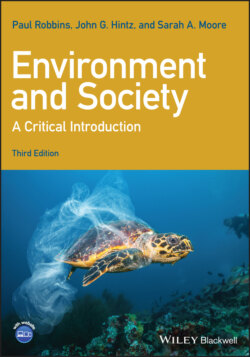Читать книгу Environment and Society - Paul Robbins - Страница 26
The Problem of Exponential Growth
ОглавлениеThese questions are by no means new either to the field of ecology or to the examination of society or policy. The concept of overpopulation is indeed ancient, though its most prominent modern adherent lived in the decades spanning the late eighteenth and early nineteenth centuries: Reverend Dr. Thomas Robert Malthus. His assertion, in its clearest form, was that the capacity of population to grow is greater than the power of the Earth to provide resources. Given the procreative capacity of humanity and the inherently finite availability of the Earth’s resources, in this way of thinking, human population is the single greatest influence on the status of the Earth and its resources. Conversely, the Earth’s resources provide the most definitive and powerful limit for human growth and expansion.
Exponential Growth A condition of growth where the rate is mathematically proportional to the current value, leading to continued, non-linear increase of the quantity; in population, this refers to a state of increasingly accelerated and compounded growth, with ecological implications for scarcity
In more careful phrasing, Malthus was clear to describe the mathematical underpinnings of this relationship, stressing that population growth is effectively “geometric” (“exponential” in today’s terms), since the multiple offspring of a single mating pair of animals or people are each capable of producing multiple offspring themselves. Assuming six children from every mating couple (a family size typical in Malthus’ time), for example, means a growth of 6 in the first generation, 18 in the second generation, 54 in the third, and so on. That growth, when graphed, takes the form of a curve, much steeper than a straight line, moving toward an asymptote, that is, a steep increase in a few generations and a large number of individuals, increasing every generation.
On the other hand, Malthus argued, the food base for this growing population over time is essentially fixed or, perhaps, amenable to slight alteration through “arithmetic” (“linear” in today’s terms) expansion. Food supplies can grow by putting more land under the plow, for example, but not nearly at the rate that population expands. Over time “geometric” growth always outpaces “arithmetic” growth, with obvious implications.
These implications sit at the center of Malthus’ key written work, An Essay on the Principle of Population (Malthus 1992), which he first published in 1798. Here, Malthus suggested, wars, famine, destitution, and disease are natural limits to growth and act to keep population in check. Second, he maintained that policies promoting the welfare of the poor are counterproductive, because they only encourage unnecessary reproduction and resource waste. Third, he argued that the key to averting periodic and inevitable resource crisis is a moral code of self-restraint.
In terms of natural limits Malthus suggested that famine, starvation, and death were predictable. He insisted, moreover, that the iron laws of scarcity meant that periodic crises and population collapses were practically inevitable, even in a world where some expansion in resources occurred over time. These hypothetical cyclical population-driven crises are sketched in Figure 2.1, which shows a model of the Malthusian dynamic of population versus natural resources.
Figure 2.1 Hypothesized demographic trends in a Malthusian conception. Limits of the environment, though they are amenable to steady increases resulting from growths in resource production, control human population trends with periods of high growth followed by periodic calamities and corrections that bring population back in line with the environment.
Malthus freely admitted that the poorest people were the most vulnerable parts of the population. He insisted, however, that efforts to sustain, protect, or subsidize the conditions of the poor were largely pointless, insofar as they bolstered or supported population growth. Malthus, though, was even harsher in his assessment of the poor. He suggested that the poor are reliant on handouts, that they are bad managers of time and money, and that they are given to irrational procreation.
Rather than provide support for people, Malthus insisted that the best remedy to these crises is the expansion of moral restraint. Specifically he intended the moral restraint of women, whom he held responsible for the maintenance of virtue and, by implication, for population run amuck. He especially focused his criticism on “less civilized” peoples (seen as those from southern Europe at that time) whom he viewed as insufficiently capable of self-control, and so inevitably given to poverty.
It can scarcely be doubted that, in modern Europe, a much larger proportion of women pass a considerable part of their lives in the exercise of virtue than in past times and among uncivilized nations. (Malthus 1992, Book II, Chapter XIII, pp. 43–44)
In some of the southern countries where every impulse may be almost immediately indulged, the passion sinks into mere animal desire, is soon weakened and extinguished by excess. (Malthus 1992, Book IV, Chapter I, p. 212)
The social and political biases of the Essay on the Principle of Population and the context in which it was written are clear. Malthus developed an explanation for poverty that absolved economic systems, political structures, or the actions of the wealthy or elite from fault. His specific moral vision of women, perhaps even by the standards of his own time, reflects a profoundly biased view of the relationship between women and men.
